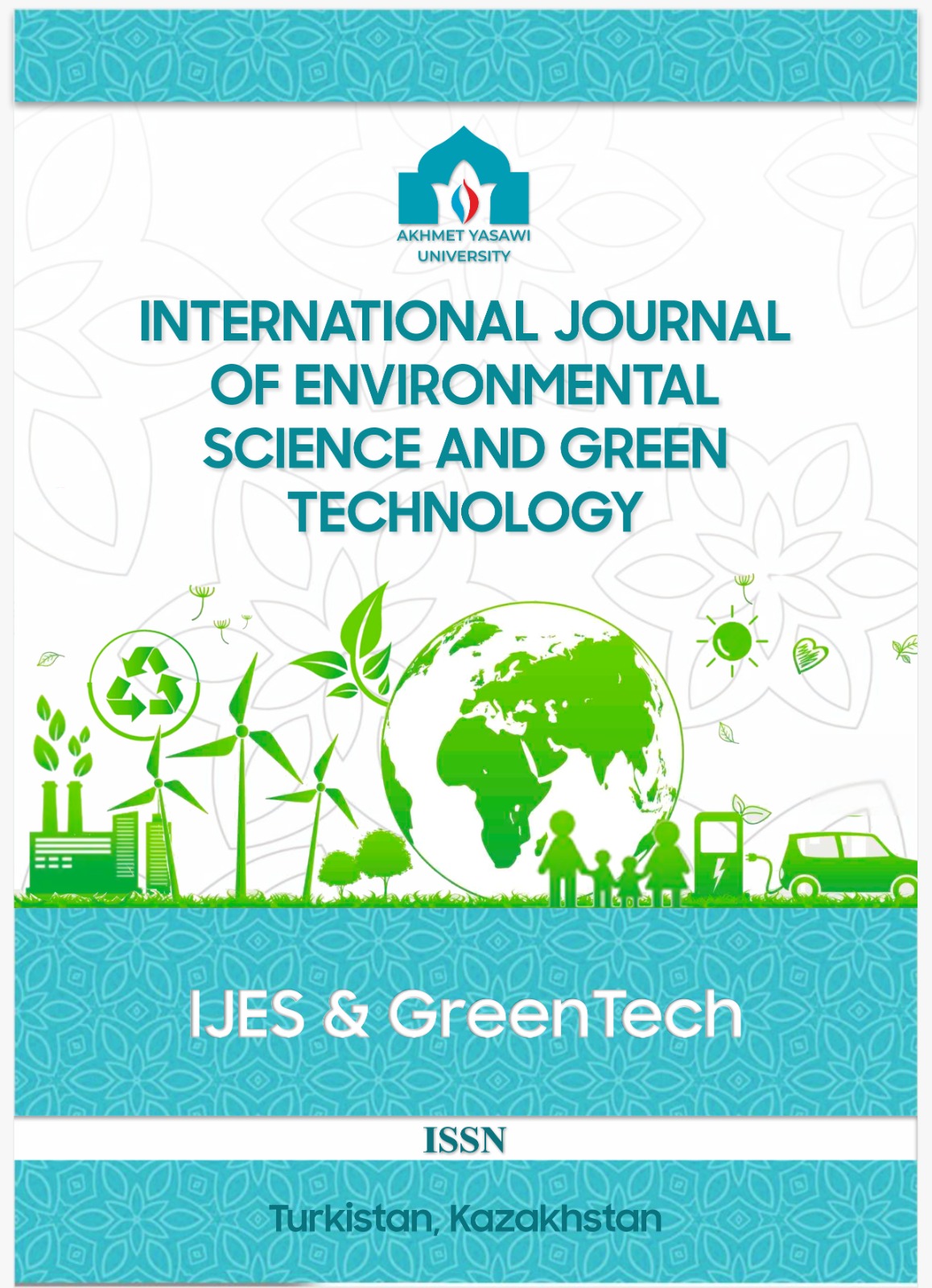Impact of Solar Incidence Angle on Output Power of PV Systems: A Field Study in Turkistan Region, Kazakhstan
164 77
DOI:
https://doi.org/10.5281/zenodo.15743788Ключевые слова:
Solar Panels, Angle of Incidence, Solar Radiation, Output Power, Solar AzimuthАннотация
This article explores the relationship between the angle of incidence of solar radiation and the output power of solar panels. The object of the study is a 26.1 kW solar power plant installed on the territory of Khoja Akhmet Yassawi International Kazakh-Turkish University. The solar panels at this station are mounted at a tilt angle of 30° and oriented to the south. The main objective of the research is to determine the optimal installation angle of the panels by identifying the effect of the angle of incidence of solar radiation on the output power. During selected time intervals in the spring season, the angle of incidence (θᵢ) was calculated based on the sun’s altitude and azimuth. The obtained angular values were compared with actual output power data retrieved from the SOLARMAN monitoring system operating in real time, and the correlation between them was analyzed. The results of the study confirmed that the performance of the panels increases as the angle of incidence decreases. In other words, the efficiency of converting solar energy into electrical energy improves when sunlight hits the panel surface more perpendicularly. This research provides valuable practical insights for optimizing the tilt angle of solar panels during the design of solar power plants. Moreover, the results of this study have the potential to enhance the educational process in the field of solar energy and can be integrated into STEM-based learning environments. This research has been/was/is funded by the Science Committee of the Ministry of Science and Higher Education of the Republic of Kazakhstan (Grant No. AP23488947)
Библиографические ссылки
Putri, N. A., Rahman, A., & Suryawan, I. W. K. (2023). Exploring the potential of solar energy in mosque buildings: a case study of dumai islamic centre mosque in riau province, indonesia. Jurnal Presipitasi: Media Komunikasi Dan Pengembangan Teknik Lingkungan, 20(3), 621-632. https://doi.org/10.14710/presipitasi.v20i3.621-632
Yılmaz, Ş., Özçalık, H. R., Doğmuş, O., Dinçer, F., Akgöl, O., & Karaaslan, M. (2015). Design of two axes sun tracking controller with analytically solar radiation calculations. Renewable and Sustainable Energy Reviews, 43, 997-1005. https://doi.org/10.1016/j.rser.2014.11.090
Pangestu, Y. F. and Santiko, I. (2023). Modeling and design for a sun tracker prototype using solar cell and arduino. Journal of Multimedia Trend and Technology, 2(3), 162-170. https://doi.org/10.35671/jmtt.v2i3.42
Muhammad, D., Hiendro, A., & Yandri, Y. (2024). Determination of tilt and azimuth angles of solar panels at tanjungpura university solar power plant using pvsyst 7.3 software simulation. Telecommunications, Computers, and Electricals Engineering Journal, 1(3), 218. https://doi.org/10.26418/telectrical.v1i3.72983
Prakash, A. and Lal, K. (2024). Assessing solar tracker effectiveness in diverse weather conditions. International Journal of Advanced Engineering Research and Science, 12-19. https://doi.org/10.22161/ijaers.115.2
Nahar, M. J., Sarkar, M. R., Uddin, M., Hossain, M. F., Rana, M. M., & Tanshen, M. R. (2021). Single axis solar tracker for maximizing power production and sunlight overlapping removal on the sensors of tracker. International Journal of Robotics and Control Systems, 1(2), 186-197. https://doi.org/10.31763/ijrcs.v1i2.333
Halim, L., Gun, S. E., & Wahab, F. (2023). Solar panel efficiency improvement through dual-axis solar tracking with fuzzy logic and water treatment techniques. Jurnal Nasional Teknik Elektro, 20-29. https://doi.org/10.25077/jnte.v12n3.1120.2023
Khelifi, E., Brahami, M. N., Bousmaha, I. S., Boudjella, F. Z., Brahami, M., Naoui, B. E. K. O., … & Mokhtaria, J. (2024). Optimizing solar panel orientation for enhanced power output in cloudy conditions: a case study on solar energy supply in a water treatment plant. Studies in Engineering and Exact Sciences, 5(1), 1740-1770. https://doi.org/10.54021/seesv5n1-088
Yılmaz, Ş., Özçalık, H. R., Doğmuş, O., Dinçer, F., Akgöl, O., & Karaaslan, M. (2015). Design of two axes sun tracking controller with analytically solar radiation calculations. Renewable and Sustainable Energy Reviews, 43, 997-1005. https://doi.org/10.1016/j.rser.2014.11.090
Esye, Y., Asbanu, H., Faturachman, D., & Chan, Y. (2024). Utilization of environmentally friendly energy in organic fertilizer processing machine. Jurnal Teknik Pertanian Lampung (Journal of Agricultural Engineering), 13(4), 1285. https://doi.org/10.23960/jtep-l.v13i4.1285-1294
Tang, R. S., Zhang, T. M., & Zhong, H. (2011). Optical performance of vertical single-axis tracked solar panels with seasonal adjustment of tilt-angles. Advanced Materials Research, 271-273, 45-51. https://doi.org/10.4028/www.scientific.net/amr.271-273.45
Khan, P. W., Byun, Y., & Lee, S. (2022). Optimal photovoltaic panel direction and tilt angle prediction using stacking ensemble learning. Frontiers in Energy Research, 10. https://doi.org/10.3389/fenrg.2022.865413

